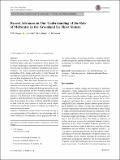Files in this item
Recent advances in our understanding of the role of meltwater in the Greenland ice sheet system
Item metadata
| dc.contributor.author | Nienow, P. W. | |
| dc.contributor.author | Sole, A. J. | |
| dc.contributor.author | Slater, Donald Alexander | |
| dc.contributor.author | Cowton, T. R. | |
| dc.date.accessioned | 2017-11-15T16:30:17Z | |
| dc.date.available | 2017-11-15T16:30:17Z | |
| dc.date.issued | 2017-12 | |
| dc.identifier | 251446816 | |
| dc.identifier | bd3d0fd9-55d3-4ee1-a499-487bd6e78820 | |
| dc.identifier | 85044309416 | |
| dc.identifier | 000461109800014 | |
| dc.identifier.citation | Nienow , P W , Sole , A J , Slater , D A & Cowton , T R 2017 , ' Recent advances in our understanding of the role of meltwater in the Greenland ice sheet system ' , Current Climate Change Reports , vol. 3 , no. 4 , pp. 330-344 . https://doi.org/10.1007/s40641-017-0083-9 | en |
| dc.identifier.issn | 2198-6061 | |
| dc.identifier.uri | https://hdl.handle.net/10023/12102 | |
| dc.description | Nienow, Sole and Cowton’s Greenland research has been supported by a number of UK NERC research grants (NER/O/S/2003/00620; NE/F021399/1; NE/H024964/1; NE/K015249/1; NE/K014609/1) and Slater has been supported by a NERC PhD studentship | en |
| dc.description.abstract | Purpose of the review: This review discusses the role that meltwater plays within the Greenland ice sheet system. The ice sheet’s hydrology is important because it affects mass balance through its impact on meltwater runoff processes and ice dynamics. The review considers recent advances in our understanding of the storage and routing of water through the supraglacial, englacial, and subglacial components of the system and their implications for the ice sheet Recent findings: There have been dramatic increases in surface meltwater generation and runoff since the early 1990s, both due to increased air temperatures and decreasing surface albedo. Processes in the subglacial drainage system have similarities to valley glaciers and in a warming climate, the efficiency of meltwater routing to the ice sheet margin is likely to increase. The behaviour of the subglacial drainage system appears to limit the impact of increased surface melt on annual rates of ice motion, in sections of the ice sheet that terminate on land, while the large volumes of meltwater routed subglacially deliver significant volumes of sediment and nutrients to downstream ecosystems. Summary: Considerable advances have been made recently in our understanding of Greenland ice sheet hydrology and its wider influences. Nevertheless, critical gaps persist both in our understanding of hydrology-dynamics coupling, notably at tidewater glaciers, and in runoff processes which ensure that projecting Greenland’s future mass balance remains challenging. | |
| dc.format.extent | 834661 | |
| dc.language.iso | eng | |
| dc.relation.ispartof | Current Climate Change Reports | en |
| dc.subject | Greenland ice sheet | en |
| dc.subject | Ice sheet hydrology | en |
| dc.subject | Ice dynamics | en |
| dc.subject | Tidewater glaciers | en |
| dc.subject | Sediment and solute fluxes | en |
| dc.subject | Ice sheet erosion | en |
| dc.subject | GE Environmental Sciences | en |
| dc.subject | QE Geology | en |
| dc.subject | SDG 13 - Climate Action | en |
| dc.subject | SDG 15 - Life on Land | en |
| dc.subject.lcc | GE | en |
| dc.subject.lcc | QE | en |
| dc.title | Recent advances in our understanding of the role of meltwater in the Greenland ice sheet system | en |
| dc.type | Journal item | en |
| dc.contributor.institution | University of St Andrews. School of Geography & Sustainable Development | en |
| dc.contributor.institution | University of St Andrews. Bell-Edwards Geographic Data Institute | en |
| dc.identifier.doi | https://doi.org/10.1007/s40641-017-0083-9 | |
| dc.description.status | Peer reviewed | en |
This item appears in the following Collection(s)
Items in the St Andrews Research Repository are protected by copyright, with all rights reserved, unless otherwise indicated.

